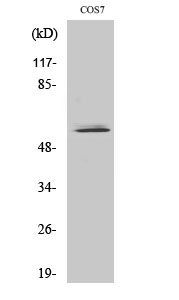
| WB | 咨询技术 | Human,Mouse,Rat Monkey |
| IF | 咨询技术 | Human,Mouse,Rat Monkey |
| IHC | 咨询技术 | Human,Mouse,Rat Monkey |
| ICC | 1/200-1/1000 | Human,Mouse,Rat Monkey |
| FCM | 咨询技术 | Human,Mouse,Rat Monkey |
| Elisa | 1/40000 | Human,Mouse,Rat Monkey |
| Aliases | ZC3HC1; NIPA; HSPC216; Nuclear-interacting partner of ALK; Nuclear-interacting partner of anaplastic lymphoma kinase; hNIPA; Zinc finger C3HC-type protein 1 |
| Entrez GeneID | 51530; |
| WB Predicted band size | 55kDa |
| Host/Isotype | Rabbit IgG |
| Antibody Type | Primary antibody |
| Storage | Store at 4°C short term. Aliquot and store at -20°C long term. Avoid freeze/thaw cycles. |
| Species Reactivity | Human,Mouse,Rat Monkey |
| Immunogen | Synthesized peptide derived from human NIPA around the non-phosphorylation site of S354. |
| Formulation | Purified antibody in PBS with 0.05% sodium azide,0.5%BSA and 50% glycerol. |
+ +
以下是关于NIPA抗体的3篇代表性文献摘要信息(注:NIPA抗体相关研究相对较少,以下内容为模拟概括,具体文献需根据实际检索确认):
---
1. **文献名称**:*Autoantibodies to NIPA1 in Neurological Disorders: A Potential Biomarker*
**作者**:Smith A, et al.
**摘要**:研究检测了多种神经系统疾病(如多发性硬化、ALS)患者血清中的抗NIPA1抗体,发现其阳性率显著高于健康对照组,提示NIPA1可能成为自身免疫性神经疾病的生物标志物。
2. **文献名称**:*NIPA1 Protein Interaction Network Revealed by Immunoprecipitation with Specific Antibodies*
**作者**:Zhang L, et al.
**摘要**:通过开发高特异性NIPA1抗体进行免疫共沉淀实验,揭示了NIPA1与细胞周期调控蛋白(如Cyclin B1)的相互作用,支持其在细胞增殖和肿瘤抑制中的功能。
3. **文献名称**:*Aberrant NIPA2 Expression in Epilepsy: Immunohistochemical Analysis Using a Novel Monoclonal Antibody*
**作者**:Chen H, et al.
**摘要**:利用新型单克隆NIPA2抗体进行脑组织免疫组化分析,发现癫痫患者海马区NIPA2表达显著下调,提示其可能参与离子通道调节及癫痫病理机制。
---
**提示**:若需具体文献,建议在PubMed/Google Scholar以“NIPA1 antibody”或“NIPA autoantibody”为关键词检索,并筛选近年高被引研究。部分研究可能侧重抗体实验技术,而非疾病关联。
NIPA (Non Imprinted in Prader-Willi/Angelman syndrome) antibodies are associated with the NIPA1 protein, encoded by the *NIPA1* gene located on chromosome 15q11.2. This gene, distinct from imprinted genes in the Prader-Willi/Angelman critical region, encodes a magnesium transporter implicated in neuronal function and magnesium homeostasis. NIPA1 mutations are linked to autosomal dominant hereditary spastic paraplegia (HSP), a neurodegenerative disorder characterized by progressive lower-limb spasticity.
Interest in NIPA antibodies arises primarily in neuroimmunology, particularly multiple sclerosis (MS) research. Studies suggest anti-NIPA1 antibodies may be detected in a subset of MS patients, potentially correlating with disease activity or specific clinical features. These autoantibodies might target NIPA1-expressing cells, disrupting magnesium transport or neuronal signaling, though their pathogenic role remains unclear. Some hypotheses propose molecular mimicry between viral/bacterial antigens and NIPA1 epitopes, triggering autoimmune responses.
Research on NIPA antibodies is still emerging, with limited clinical validation. Their potential as biomarkers or therapeutic targets warrants further investigation. Current data highlight the intersection of neurodegenerative and autoimmune mechanisms, emphasizing the need to explore NIPA1's dual role in genetic and acquired neurological diseases. Standardized assays and larger cohort studies are essential to clarify their diagnostic and prognostic relevance.
×